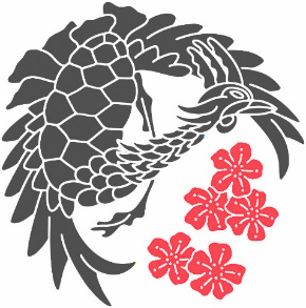(A) The Phoenix Pavilion
Image: March 31, 1893 Dedication
Introducing Japanese History and Culture to the World
On March 31, 1893, the United States and Japan dedicated the Ho-o-den (Phoenix Pavilion) on the Wooded Island. Never before had the nation been given such a locus for learning about Japan, nor did a building ever have so many meanings and hopes cast upon it.
Image: The Phoenix Pavilion, worker’s cottage, and Japanese Bridge
The Phoenix Pavilion was deliberately designed to showcase for the first time in America the greatest achievements of Japan’s artistic heritage.
For the millions of visitors to the World’s Columbian Exposition during its six-month run beginning May 1, 1893, the building - and the canon of Japanese art that it contained - would begin to transform their understanding and appreciation of Japan and its people.
At the close of the Exposition, the Phoenix Pavilion was gifted by the Emperor of Japan to the City of Chicago to serve not only as a symbol of the relationship between Japan and the United States, but to be a place for future generations to continue to learn about Japan.
Image: Backside of the Phoenix Pavilion, Japanese Worker’s Cottage
Modeled after a 12th Century Temple
The Phoenix Pavilion in Chicago was modeled after a noted building called the Hōōdō, or Phoenix Hall, located in Uji, near Kyoto. Built in 1052, the Hōōdō is recognized as one of the most important examples of classical Japanese architecture, and remains a symbol of Japan today.
The Chicago version was given the name Ho-o-den, or Phoenix Pavilion, signifying that it was modified from a sacred Buddhist worship hall to one of secular purpose. The Phoenix Pavilion consisted of a central hall with two identical smaller structures situated on each side that were connected by a roofed pergola. The arrangement of the buildings was intended to represent the head and body, and flanking wings, of the Phoenix.
The Phoenix Pavilion in Detail
The interior of each building was elaborately decorated to display the distinct style of a significant period of Japanese art and architecture.
The north wing was in the manner of the Fujiwara (Heian) Period (980-1185), with features taken from those of the Phoenix Hall at Uji and the Imperial Palace at Kyoto.
The south wing was in the style of the Ashikaga (Muromachi) (1333-1568), with features resembling Ginkakuji, or Silver Pavilion, built in Kyoto in the late-fifteenth century.
The large central hall reflected the taste of the Tokugawa (Edo) Period (1615-1867), and included ranma, or wooden transom panels, designed and carved by master sculptor Kōun Takamura (1852-1934).



















